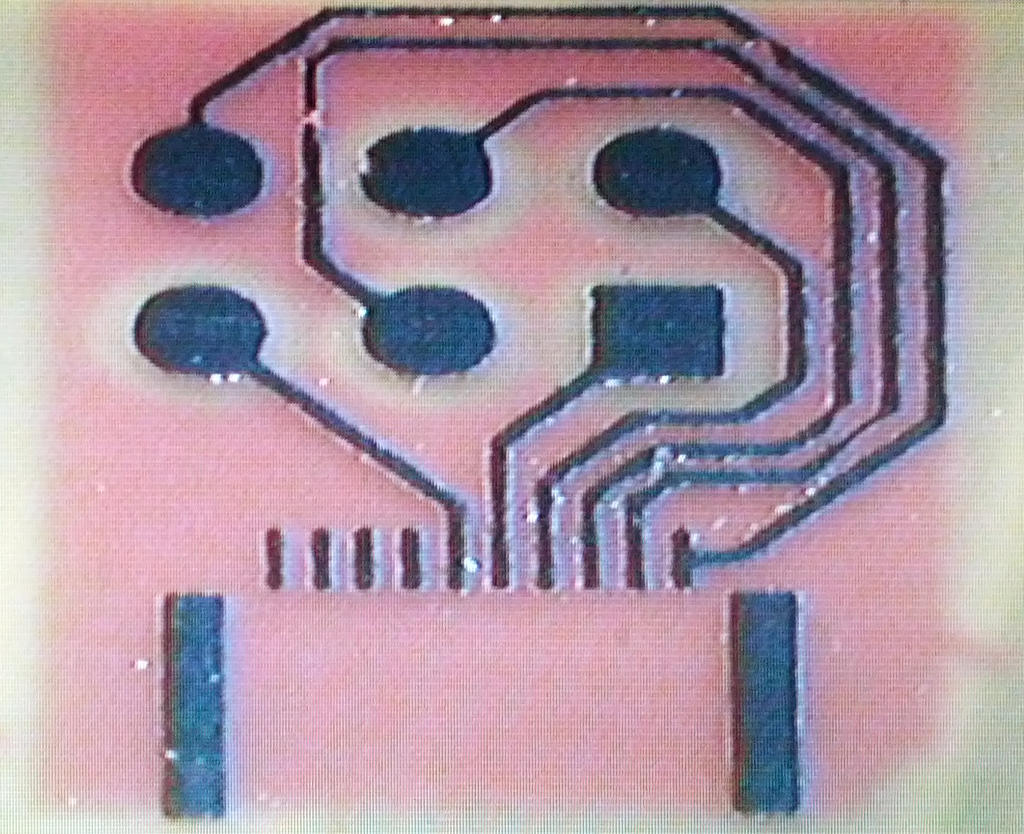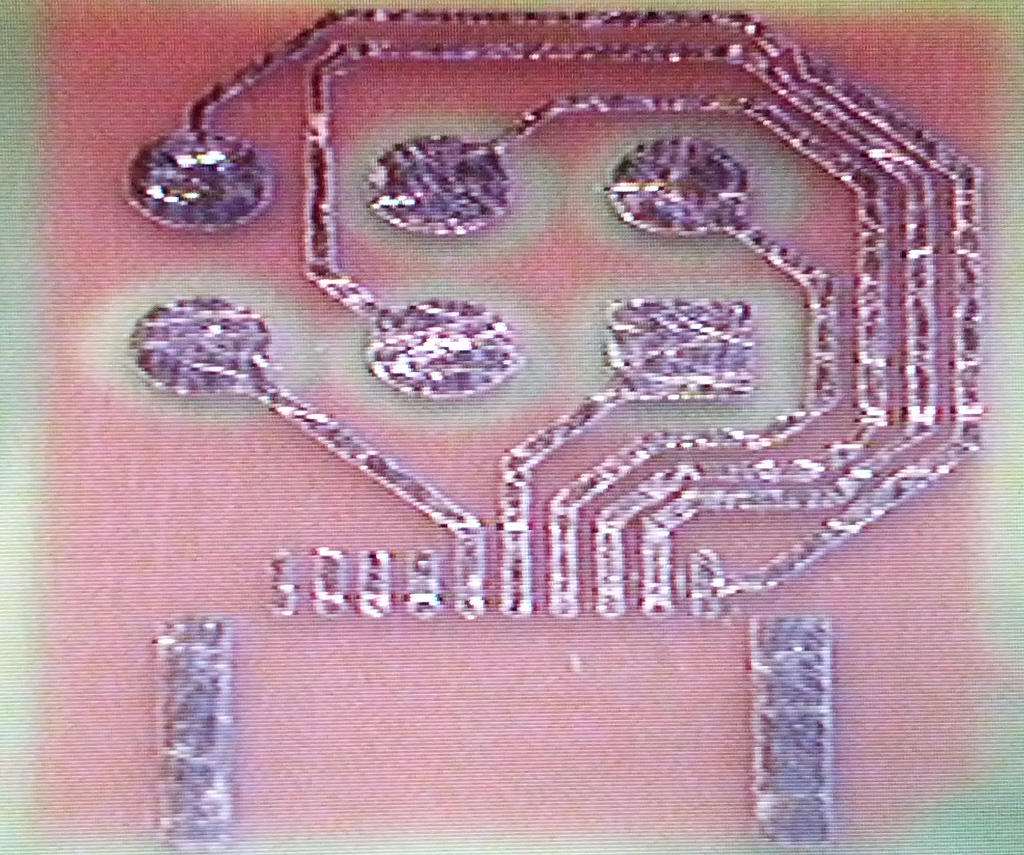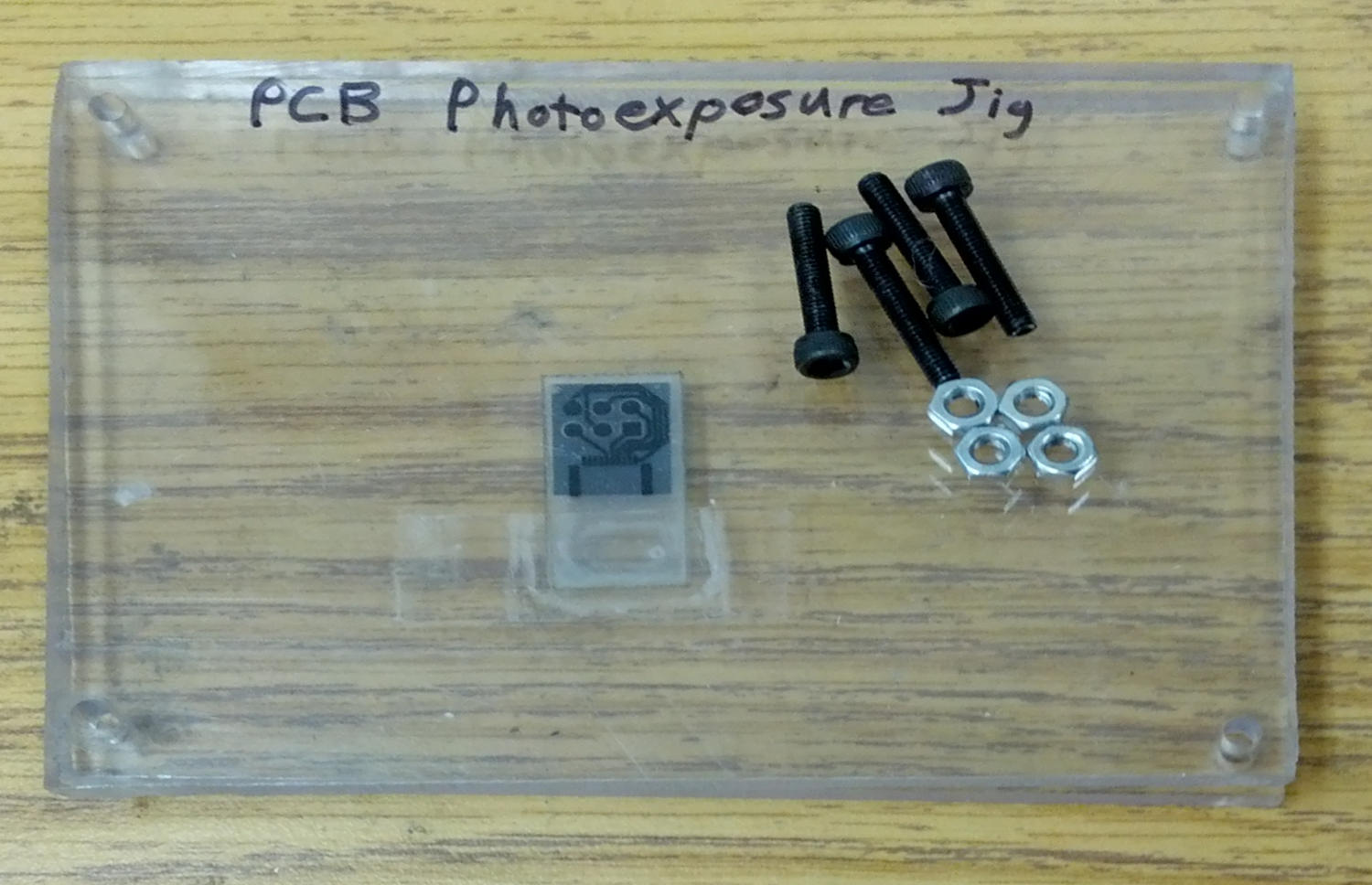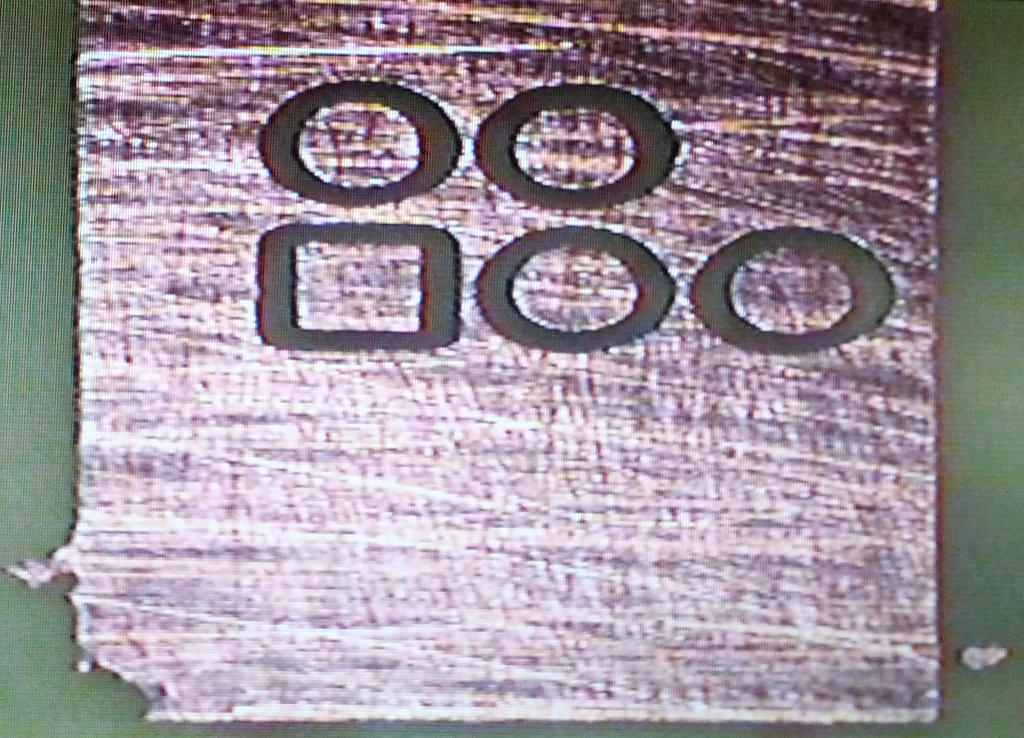Photolithography PCB Fab: Difference between revisions
From HacDC Wiki
No edit summary |
No edit summary |
||
| (31 intermediate revisions by the same user not shown) | |||
| Line 11: | Line 11: | ||
=PCB Design= | =PCB Design= | ||
Recommend gEDA. Project template with CNC Mill and gerber export scripts available on [https://github.com/mirage335/gEDA_Template github]. Photolithography scripts are specifically provided at [https://github.com/ | Recommend gEDA. Project template with CNC Mill and gerber export scripts available on [https://github.com/mirage335/gEDA_Template github]. Photolithography scripts are specifically provided at [https://github.com/mirage335/gedaProduction/tree/master/hacdcPhotoLithography hacdcPhotoLithography subfolder] of the [https://github.com/mirage335/gedaProduction gedaProduction repository]. | ||
=Design Rules= | =Design Rules= | ||
| Line 24: | Line 24: | ||
</blockquote> | </blockquote> | ||
Note slightly better resolution is routinely feasible with practice. | Recommend most traces be kept to 10mil width, especially long traces. Note slightly better resolution is routinely feasible with practice. | ||
=Process= | =Process= | ||
Simple, consisting of: | Simple, consisting of: | ||
# Photosensitive copper clad board. If not already available, more can be made by laminating dry film photoresist to bare copper clad board. | # Photosensitive copper clad board. If not already available, more can be made by laminating dry film photoresist to bare copper clad board. | ||
# Via/hole drilling, outline milling, etc. Best done automatically on CNC mill. | # Via/hole drilling, outline milling, etc. Best done automatically on CNC mill. Please be careful to terminate outline cutting once complete, do not allow the endmill to bind. | ||
# Photomask. Printed on transparencies at high-resolution. Inkjet printers, >600dpi, do well, given true inkjet transparencies. Some laser printers may require double layer photomasks. Alternatively, <445nm lasers may be able to selectively expose the photoresist. | # Photomask. Printed on transparencies at high-resolution. Inkjet printers, >600dpi, do well, given true inkjet transparencies. Some laser printers may require double layer photomasks. Alternatively, <445nm lasers may be able to selectively expose the photoresist. | ||
# UV exposure. Sunlight or high-brightness CFL bulbs can expose the photoresist in ~30 minutes. | # UV exposure. Sunlight or high-brightness CFL bulbs can expose the photoresist in ~5-30 minutes. EEPROM eraser boxes with timers are best. Even exposure is critical, and timing is critical for lower-contrast photomasks. | ||
# Development. Use a foam brush with the appropriate developer solution from the chemicals shelf. | # Development. Use a foam brush with the appropriate developer solution from the chemicals shelf. Alternatively, a warm bath can quickly provide better consistency across large boards, particularly if photodeveloper includes silicate. | ||
# Etching. Recommend a sponge with ferric chloride to remove exposed copper. This is quicker and less wasteful than the "bath" process. | # Etching. Recommend a sponge with ferric chloride to remove exposed copper. This is quicker and less wasteful than the "bath" process. | ||
# Carefully repeat above two steps as necessary to isolate all traces. | # Carefully repeat above two steps as necessary to isolate all traces. | ||
| Line 46: | Line 46: | ||
# Place components on the appropriate pads. | # Place components on the appropriate pads. | ||
# Carefully melt the solder with the hot-air reflow tool. Hold the hot-air tool close to the components at 400C and maximum airflow, watch carefully, and progressively move the tool across the board as solder melts. | # Carefully melt the solder with the hot-air reflow tool. Hold the hot-air tool close to the components at 400C and maximum airflow, watch carefully, and progressively move the tool across the board as solder melts. | ||
Note that this process is somewhat incompatible with hand-soldered vias. | |||
=Resources= | =Resources= | ||
HacDC has the requisite resources: | HacDC has the requisite resources: | ||
* Permanently installed workroom incandescent safe light. | |||
* Flourescent light array exposure lamp. | |||
* Modified EEPROM exposure box including timer, germicidal lamp, foam backing, and laser-cut acrylic PCB/photomask holding jig. | * Modified EEPROM exposure box including timer, germicidal lamp, foam backing, and laser-cut acrylic PCB/photomask holding jig. | ||
* Standalone polycarbonate and acrylic PCB/photomask holding jigs, for use with alternative light sources. | * Standalone polycarbonate and acrylic PCB/photomask holding jigs, for use with alternative light sources. | ||
* Laser printer | * Laser printer. | ||
* Transparencies. | * Transparencies. | ||
* Positive photosensitive copper clad board. | * Positive photosensitive copper clad board (typically including 590-660). | ||
* Negative photosensitive copper clad board. | * Negative photosensitive copper clad board. | ||
* Negative dry film photoresist. | * Negative dry film photoresist. | ||
| Line 71: | Line 75: | ||
Aligned reverse side. | Aligned reverse side. | ||
[[File:DevelopedEtchedStrippedTested_Reverse.jpg|500px]] | [[File:DevelopedEtchedStrippedTested_Reverse.jpg|500px]] | ||
=Safety= | |||
Please be careful with the chemicals, most of which are strong acids or bases. Strictly avoid contact and vapors. Nitrile gloves are available. Immediately rinse and move to fresh air after any accidental contact. | |||
Generally, the most hazardous operations involve the etchant bath, and preparing fresh photodeveloper. The actual PCB fabrication process itself, applying an etchant bottle to a sponge and using non-concentrate photodeveloper, is relatively simple. | |||
=Reference= | =Reference= | ||
| Line 86: | Line 95: | ||
* DLP projector maskless lithography. | * DLP projector maskless lithography. | ||
* Tracing paper photomasks, as reported at [http://www.electricstuff.co.uk/pcbs.html]. | * Tracing paper photomasks, as reported at [http://www.electricstuff.co.uk/pcbs.html]. | ||
* Polyester drafting film, as reported at [http://www.amazon.co.uk/dp/B00378TP12/?tag=-af-21#customerReviews]. | |||
* Official MG Chemicals photomask transparency sheets - [http://www.mgchemicals.com/products/prototyping-and-circuit-repair/prototyping/transparency-film-416-t/] . | |||
* Professionally printed or phototypeset photomask (perhaps kinkos does this). | |||
* PCB processing spray tanks for developing and etching. Expected to improve quality and ease of use, allowing higher yields and more attempts as necessary. | * PCB processing spray tanks for developing and etching. Expected to improve quality and ease of use, allowing higher yields and more attempts as necessary. | ||
* CircuitWriter repair pen to repair scratched or undercut traces. | |||
* Conductive ink, rivet (http://www.megauk.com/through_hole_rivets.php), or 'bar' (http://www.technick.net/public/code/cp_dpage.php?aiocp_dp=guide_pcb) through-hole connections. Apparently, the rivets can be used without the expensive punch tool (http://www.electricstuff.co.uk/pcbs.html). | |||
* Spray on photoresist, for repeat exposures. Quality results with spray resists have been reported at http://www.marwynandjohn.org.uk/GM8OTI/projopticalpcb/projopticalpcb.html . | |||
==Full-Scale Process== | |||
Professional PCB fabs manufacture upwards of dozens of PCBs per hour, with resulting boards ready for rapid solderpaste stencil based PCB assembly. Efforts are underway to implement required DLP projection and spray tank equipment for at least part of this process, a description of which follows: | |||
===Dual-Layer Boards=== | |||
====Templates==== | |||
# Positive presensitzed board, negative artwork (dark regions cover desired copper). | |||
# Predrilling if dual pre-aligned DLP projection is not available. | |||
# UV '''photoexposure''', high contrast, using DLP projection. | |||
====Photo-Patterning==== | |||
# Warm '''photodevelopment''' bath (exposes desired copper). | |||
# '''Rinse''' spray (pH should be neutral -<1.5). | |||
==== Processing ==== | |||
# Via/hole '''drilling''', if not done already. | |||
# '''Conductive coating''', to activate through-holes (http://www.thinktink.com/stack/volumes/volvi/condink.htm). | |||
# Recirculated '''electroplating''' bath (adds copper everywhere, including holes). Requires specialized copper plating solution (http://www.thinktink.com/stack/volumes/voliii/consumbl/cplatmix.htm) . | |||
# Liquid '''tin plating''' (simple bath, no spraying) covers everything with tin, which resists etchant. | |||
# '''Photoresist stripping''' with concentrated sodium hydroxide. | |||
# '''Etching''' spray removes bare copper, leaves previously tinplated surfaces unharmed. | |||
# '''Rinse''' spray (pH should be neutral -<1.5). | |||
# '''Tin stripping''' spray (http://www.alliedelec.com/search/productdetail.aspx?SKU=70125740) leaves bare copper. | |||
# '''Rinse''' spray (pH should be neutral -<1.5). | |||
===Multilayer Boards=== | |||
Similar to dual-layer boards. However, interior layers are processed first as two sided PCBs, with exterior processing and through-hole plating taking place after inter-layer bonding. Preferably, drilling also takes place after inter-layer bonding. | |||
==== Templates ==== | |||
# Positive presensitzed board, negative artwork (dark regions cover desired copper), ''single-sided for exterior layers'', ''double-sided for interior layers''. | |||
# Predrill registration holes in panel corners. In additional to presensitized board, pre-preg should also be predrilled. | |||
# Predrill all holes if dual pre-aligned DLP projection is not available. In additional to presensitized board, pre-preg should also be predrilled. Beware separately predrilled layers may fail to electrically connect in multilayer boards. | |||
==== Photo-Patterning (All Layers) ==== | |||
# UV '''photoexposure''', high contrast, using DLP projection. | |||
# Warm '''photodevelopment''' bath (exposes desired copper). | |||
# '''Rinse''' spray (pH should be neutral -<1.5). | |||
All layers should now have correctly developed/patterned photoresist on bare thin copper. | |||
==== Interior Processing ==== | |||
# Recirculated '''electroplating''' bath (adds copper everywhere, except holes). Requires specialized copper plating solution (http://www.thinktink.com/stack/volumes/voliii/consumbl/cplatmix.htm) . | |||
# Liquid '''tin plating''' (simple bath, no spraying) covers everything with tin, which resists etchant. | |||
# '''Photoresist stripping''' with concentrated sodium hydroxide. | |||
# '''Etching''' spray removes bare copper, leaves previously tinplated surfaces unharmed. | |||
# '''Rinse''' spray (pH should be neutral -<1.5). | |||
# '''Tin stripping''' spray (http://www.alliedelec.com/search/productdetail.aspx?SKU=70125740) leaves bare copper. | |||
# '''Rinse''' spray (pH should be neutral -<1.5). | |||
Interior layers should now be fully processed, down to thick patterned copper. | |||
==== Bonding ==== | |||
# '''Bond''' stack with heated press and adhesive (ideally pre-preg). | |||
Completed interior layers are now buried, with exterior layers still holding developed/patterned photoresist on bare thin copper. | |||
==== Exterior Layers & Through-Holes ==== | |||
# Via/hole '''drilling''', ideally now instead of predrilling. | |||
# '''Conductive coating''', to activate through-holes (http://www.thinktink.com/stack/volumes/volvi/condink.htm). | |||
# Recirculated '''electroplating''' bath (adds copper everywhere, especially holes). Requires specialized copper plating solution (http://www.thinktink.com/stack/volumes/voliii/consumbl/cplatmix.htm) . | |||
# Liquid '''tin plating''' (simple bath, no spraying) covers everything with tin, which resists etchant. | |||
# '''Etching''' spray removes bare copper, leaves previously tinplated surfaces unharmed. | |||
# '''Rinse''' spray (pH should be neutral -<1.5). | |||
# '''Tin stripping''' spray (http://www.alliedelec.com/search/productdetail.aspx?SKU=70125740) leaves bare copper. | |||
# '''Rinse''' spray (pH should be neutral -<1.5). | |||
Exterior layers should now be fully processed, down to thick patterned copper. Through-holes should have been plated along with exterior layers. Interior layers are completed, with via copper edges adjoining the through-hole plating. Tin plating should have protected the through-holes and associated copper joints. | |||
At this point, the multilayer board should be physically and electrically flawless, ready for high-temperature soldering. | |||
=== Soldermask === | |||
Completely optional, but easy with the tools and supplies within arm's reach. Laminate top and bottom copper with two layers of dry film resist, photoexpose, and develop. | |||
===Expensive Components=== | |||
* 3 * $90 - SHURflo Industrial Pump Model #2088-594-154 114V Corrosion Resistant Pumps (Electroplating, etching, tin stripping spray tanks). Don't bother looking for another pump, this one has actually been used in an etchant sprayer system, and can be expected to survive the extremely harsh chemicals. | |||
* 4 * $15 - [http://www.ebay.com/itm/1x-KINSTEN-Etching-Plating-Heater-EPH-20-300W-110V-Taiwan-/170942808453?pt=LH_DefaultDomain_0&hash=item27ccfc4185&afsrc=1 Specialized Heater] (Photodevelopment bath, electroplating, etching, tin stripping spray tanks). | |||
* 36 * $2 - Toro 3GPH Mister | |||
* 2 * ~$150 DLP Projector | |||
Minimum cost to implement the full system is therefore around $700, a $1k budget is probably reasonable. Better projectors may be worth investing in, to ensure highly successful fabrication results are achieved. | |||
Higher resolution, lower-cost microscopic projection systems for mounting on RepRap type machines are also underway. | |||
===Environmental Concerns=== | |||
Cupric Chloride (typically the green stuff) should be used as the etchant, as it can be recharged completely with atmospheric oxygen and hydrochloric acid. However, Ferric Chloride should be used initially, as it performs better with less tendency to 'grow'. | |||
Latest revision as of 22:40, 11 February 2016
When the 10mil isolation paths offered by CNC Milling are insufficient, photolithography becomes the PCB fabrication method of choice.
Large Boards
For large boards, note the following:
- Foam backing will be needed to press the PCB evenly against a photomask. Otherwise, acrylic (and similar) frames may bubble under pressure, allowing the photomask to 'pop-up' in the middle.
- During chemical processing, alternate between photodeveloper and etchant. Proceed with etchant only when all exposed regions are changing color. Otherwise, problems with ultrathin photoresist residue may remain.
- Avoid placing UV light sources in extreme proximity to the board. Doing so may unevenly expose some regions.
PCB Design
Recommend gEDA. Project template with CNC Mill and gerber export scripts available on github. Photolithography scripts are specifically provided at hacdcPhotoLithography subfolder of the gedaProduction repository.
Design Rules
Recommend at least the following tolerances:
- 6 mil (0.15mm) feature size (traces and spacing)
- 34 mil (0.85mm) hole size with 8 mil (0.21mm) annular ring size (50mil/1.25mm outside diameter) - fits most through-hole components, standardization on one size obviates manual milling bit swapping
- 25 mil minimum hole size - tested for milldrilling
For comparison, oshpark offers:
The minimum specs for 2 layer orders are 6 mil traces with 6 mil spacing, and 13 mil drills with 7 mil annular rings.
Recommend most traces be kept to 10mil width, especially long traces. Note slightly better resolution is routinely feasible with practice.
Process
Simple, consisting of:
- Photosensitive copper clad board. If not already available, more can be made by laminating dry film photoresist to bare copper clad board.
- Via/hole drilling, outline milling, etc. Best done automatically on CNC mill. Please be careful to terminate outline cutting once complete, do not allow the endmill to bind.
- Photomask. Printed on transparencies at high-resolution. Inkjet printers, >600dpi, do well, given true inkjet transparencies. Some laser printers may require double layer photomasks. Alternatively, <445nm lasers may be able to selectively expose the photoresist.
- UV exposure. Sunlight or high-brightness CFL bulbs can expose the photoresist in ~5-30 minutes. EEPROM eraser boxes with timers are best. Even exposure is critical, and timing is critical for lower-contrast photomasks.
- Development. Use a foam brush with the appropriate developer solution from the chemicals shelf. Alternatively, a warm bath can quickly provide better consistency across large boards, particularly if photodeveloper includes silicate.
- Etching. Recommend a sponge with ferric chloride to remove exposed copper. This is quicker and less wasteful than the "bath" process.
- Carefully repeat above two steps as necessary to isolate all traces.
- Striping. Sodium hydroxide completely removes photoresist. May need additional UV exposure.
- Solder mask. Optional. Laminate two dry film photoresist sheets onto the PCB, apply photomask, expose, and develop. Alternatively, laser cut a negative solder mask from blue tape, and apply high-temperature spraypaint.
Assembly
For large boards with hundreds of components, reflow can be quicker than manual soldering.
- Laser cut solder paste stencil from blue tape. Apply stencil to PCB.
- Add smooth, paper thin layer of solder paste with a razor.
- Remove stencil.
- Place components on the appropriate pads.
- Carefully melt the solder with the hot-air reflow tool. Hold the hot-air tool close to the components at 400C and maximum airflow, watch carefully, and progressively move the tool across the board as solder melts.
Note that this process is somewhat incompatible with hand-soldered vias.
Resources
HacDC has the requisite resources:
- Permanently installed workroom incandescent safe light.
- Flourescent light array exposure lamp.
- Modified EEPROM exposure box including timer, germicidal lamp, foam backing, and laser-cut acrylic PCB/photomask holding jig.
- Standalone polycarbonate and acrylic PCB/photomask holding jigs, for use with alternative light sources.
- Laser printer.
- Transparencies.
- Positive photosensitive copper clad board (typically including 590-660).
- Negative photosensitive copper clad board.
- Negative dry film photoresist.
- Bare copper clad board, various types and thicknesses.
- Various photodeveloper chemicals. Use the positive developer solution and foam brush for positive resists, sodium carbonate (washing soda) for negative resists.
- Lots of copper dissolving etchant, various types, some good, some bad.
- CNC Mill.
- A heated and bubbled etchant bath has been constructed by mirage335. While reasonably quick (~15 minutes) and consistent, this is not recommended, as components degrade quickly, and the resulting acid vapor is extremely harsh.
Demo
Chemically developed and etched PCB. Photoresist remaining.

Photoresist stripped, bare copper PCB electrically tested.

Safety
Please be careful with the chemicals, most of which are strong acids or bases. Strictly avoid contact and vapors. Nitrile gloves are available. Immediately rinse and move to fresh air after any accidental contact.
Generally, the most hazardous operations involve the etchant bath, and preparing fresh photodeveloper. The actual PCB fabrication process itself, applying an etchant bottle to a sponge and using non-concentrate photodeveloper, is relatively simple.
Reference
http://www.instructables.com/id/Killer-PCBs/ http://www.mgchemicals.com/downloads/pdf/negativePrototyping.pdf http://www.instructables.com/id/Sponge-Ferric-Chloride-Method-Etch-Circuit-Bo/
Credit
Many thanks to:
- Dan Barlow
Research Underway
- Better photodeveloper. The MG Chemicals product works reasonably well thus far, but may not include sodium silicate. [Reportedly] RS-Components 690-849 is far superior, allowing development in seconds with lower risks of overdevelopment.
- Alternative photoresist, as reported at [1].
- DLP projector maskless lithography.
- Tracing paper photomasks, as reported at [2].
- Polyester drafting film, as reported at [3].
- Official MG Chemicals photomask transparency sheets - [4] .
- Professionally printed or phototypeset photomask (perhaps kinkos does this).
- PCB processing spray tanks for developing and etching. Expected to improve quality and ease of use, allowing higher yields and more attempts as necessary.
- CircuitWriter repair pen to repair scratched or undercut traces.
- Conductive ink, rivet (http://www.megauk.com/through_hole_rivets.php), or 'bar' (http://www.technick.net/public/code/cp_dpage.php?aiocp_dp=guide_pcb) through-hole connections. Apparently, the rivets can be used without the expensive punch tool (http://www.electricstuff.co.uk/pcbs.html).
- Spray on photoresist, for repeat exposures. Quality results with spray resists have been reported at http://www.marwynandjohn.org.uk/GM8OTI/projopticalpcb/projopticalpcb.html .
Full-Scale Process
Professional PCB fabs manufacture upwards of dozens of PCBs per hour, with resulting boards ready for rapid solderpaste stencil based PCB assembly. Efforts are underway to implement required DLP projection and spray tank equipment for at least part of this process, a description of which follows:
Dual-Layer Boards
Templates
- Positive presensitzed board, negative artwork (dark regions cover desired copper).
- Predrilling if dual pre-aligned DLP projection is not available.
- UV photoexposure, high contrast, using DLP projection.
Photo-Patterning
- Warm photodevelopment bath (exposes desired copper).
- Rinse spray (pH should be neutral -<1.5).
Processing
- Via/hole drilling, if not done already.
- Conductive coating, to activate through-holes (http://www.thinktink.com/stack/volumes/volvi/condink.htm).
- Recirculated electroplating bath (adds copper everywhere, including holes). Requires specialized copper plating solution (http://www.thinktink.com/stack/volumes/voliii/consumbl/cplatmix.htm) .
- Liquid tin plating (simple bath, no spraying) covers everything with tin, which resists etchant.
- Photoresist stripping with concentrated sodium hydroxide.
- Etching spray removes bare copper, leaves previously tinplated surfaces unharmed.
- Rinse spray (pH should be neutral -<1.5).
- Tin stripping spray (http://www.alliedelec.com/search/productdetail.aspx?SKU=70125740) leaves bare copper.
- Rinse spray (pH should be neutral -<1.5).
Multilayer Boards
Similar to dual-layer boards. However, interior layers are processed first as two sided PCBs, with exterior processing and through-hole plating taking place after inter-layer bonding. Preferably, drilling also takes place after inter-layer bonding.
Templates
- Positive presensitzed board, negative artwork (dark regions cover desired copper), single-sided for exterior layers, double-sided for interior layers.
- Predrill registration holes in panel corners. In additional to presensitized board, pre-preg should also be predrilled.
- Predrill all holes if dual pre-aligned DLP projection is not available. In additional to presensitized board, pre-preg should also be predrilled. Beware separately predrilled layers may fail to electrically connect in multilayer boards.
Photo-Patterning (All Layers)
- UV photoexposure, high contrast, using DLP projection.
- Warm photodevelopment bath (exposes desired copper).
- Rinse spray (pH should be neutral -<1.5).
All layers should now have correctly developed/patterned photoresist on bare thin copper.
Interior Processing
- Recirculated electroplating bath (adds copper everywhere, except holes). Requires specialized copper plating solution (http://www.thinktink.com/stack/volumes/voliii/consumbl/cplatmix.htm) .
- Liquid tin plating (simple bath, no spraying) covers everything with tin, which resists etchant.
- Photoresist stripping with concentrated sodium hydroxide.
- Etching spray removes bare copper, leaves previously tinplated surfaces unharmed.
- Rinse spray (pH should be neutral -<1.5).
- Tin stripping spray (http://www.alliedelec.com/search/productdetail.aspx?SKU=70125740) leaves bare copper.
- Rinse spray (pH should be neutral -<1.5).
Interior layers should now be fully processed, down to thick patterned copper.
Bonding
- Bond stack with heated press and adhesive (ideally pre-preg).
Completed interior layers are now buried, with exterior layers still holding developed/patterned photoresist on bare thin copper.
Exterior Layers & Through-Holes
- Via/hole drilling, ideally now instead of predrilling.
- Conductive coating, to activate through-holes (http://www.thinktink.com/stack/volumes/volvi/condink.htm).
- Recirculated electroplating bath (adds copper everywhere, especially holes). Requires specialized copper plating solution (http://www.thinktink.com/stack/volumes/voliii/consumbl/cplatmix.htm) .
- Liquid tin plating (simple bath, no spraying) covers everything with tin, which resists etchant.
- Etching spray removes bare copper, leaves previously tinplated surfaces unharmed.
- Rinse spray (pH should be neutral -<1.5).
- Tin stripping spray (http://www.alliedelec.com/search/productdetail.aspx?SKU=70125740) leaves bare copper.
- Rinse spray (pH should be neutral -<1.5).
Exterior layers should now be fully processed, down to thick patterned copper. Through-holes should have been plated along with exterior layers. Interior layers are completed, with via copper edges adjoining the through-hole plating. Tin plating should have protected the through-holes and associated copper joints.
At this point, the multilayer board should be physically and electrically flawless, ready for high-temperature soldering.
Soldermask
Completely optional, but easy with the tools and supplies within arm's reach. Laminate top and bottom copper with two layers of dry film resist, photoexpose, and develop.
Expensive Components
- 3 * $90 - SHURflo Industrial Pump Model #2088-594-154 114V Corrosion Resistant Pumps (Electroplating, etching, tin stripping spray tanks). Don't bother looking for another pump, this one has actually been used in an etchant sprayer system, and can be expected to survive the extremely harsh chemicals.
- 4 * $15 - Specialized Heater (Photodevelopment bath, electroplating, etching, tin stripping spray tanks).
- 36 * $2 - Toro 3GPH Mister
- 2 * ~$150 DLP Projector
Minimum cost to implement the full system is therefore around $700, a $1k budget is probably reasonable. Better projectors may be worth investing in, to ensure highly successful fabrication results are achieved.
Higher resolution, lower-cost microscopic projection systems for mounting on RepRap type machines are also underway.
Environmental Concerns
Cupric Chloride (typically the green stuff) should be used as the etchant, as it can be recharged completely with atmospheric oxygen and hydrochloric acid. However, Ferric Chloride should be used initially, as it performs better with less tendency to 'grow'.


